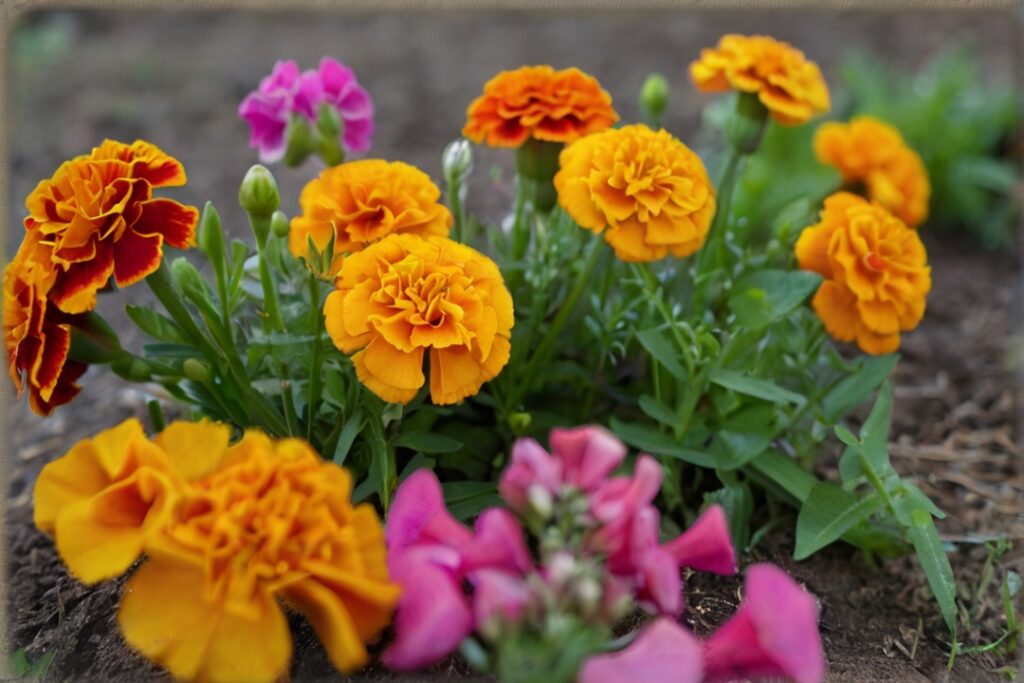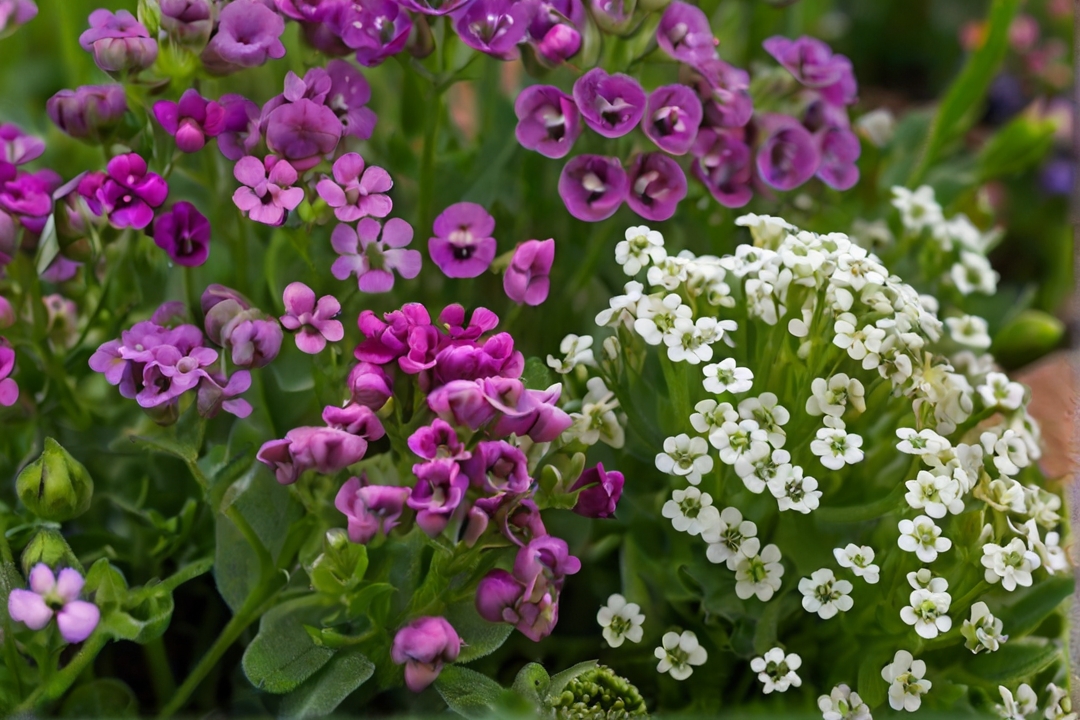Companion planting is a gardening technique that involves planting different plants together to benefit each other. It is a natural and sustainable way to promote healthy growth and protect plants from pests. Sweet peas are a popular choice for companion planting because they are easy to grow and add beauty to any garden. In this blog post, we will explore some of the best Sweet Pea Companion Plants.
Table of Contents
- Nasturtiums: A Colorful and Beneficial Companion for Sweet Peas
- Marigolds: A Natural Pest Deterrent for Sweet Peas
- Lavender: A Fragrant and Attractive Companion for Sweet Peas
- Cosmos: A Complementary Flower for Sweet Peas
- Alyssum: A Low-Growing and Hardy Companion for Sweet Peas
- Chives: A Beneficial Herb Companion for Sweet Peas
- Clematis: A Climbing and Beautiful Companion for Sweet Peas
- Snapdragon: A Tall and Showy Companion for Sweet Peas
- Dianthus: A Fragrant and Long-Lasting Companion for Sweet Peas
- FAQs
Nasturtiums: A Colorful and Beneficial Companion for Sweet Peas

Nasturtiums are a colorful and edible flower that can be planted alongside sweet peas. They not only add a vibrant touch to the garden but also attract beneficial insects like bees and butterflies, which help pollinate the sweet peas. The bright colors of nasturtiums act as a beacon, attracting these pollinators to your garden. Additionally, nasturtiums have a strong scent that can help mask the scent of sweet peas, making it harder for pests to locate them.
One of the greatest benefits of planting nasturtiums with sweet peas is their ability to repel pests like aphids and whiteflies. These pests can cause significant damage to sweet pea plants, stunting their growth and reducing their overall health. By planting nasturtiums nearby, you create a natural barrier that deters these pests from attacking your sweet peas.
Marigolds: A Natural Pest Deterrent for Sweet Peas

Marigolds are another excellent companion plant for sweet peas due to their natural pest deterrent properties. These vibrant flowers not only add a pop of color to the garden but also repel pests like nematodes and beetles, which can damage sweet pea plants. Marigolds contain compounds that emit strong scents that repel these pests, making them an effective natural pest control method.
In addition to repelling pests, marigolds also attract beneficial insects like bees and butterflies. These insects play a crucial role in pollinating sweet peas, ensuring the production of healthy and abundant blooms. By planting marigolds alongside sweet peas, you create a welcoming environment for these pollinators, increasing the chances of successful pollination.
Lavender: A Fragrant and Attractive Companion for Sweet Peas
Lavender is a fragrant and attractive companion plant for sweet peas. Its beautiful purple flowers not only add visual appeal to the garden but also repel pests like moths and fleas, which can damage sweet pea plants. The strong scent of lavender acts as a natural deterrent, keeping these pests at bay.
Furthermore, lavender attracts beneficial insects like bees and butterflies. These insects are essential for pollinating sweet peas, ensuring the production of healthy and abundant blooms. By planting lavender alongside sweet peas, you create a haven for these pollinators, increasing the chances of successful pollination.
Cosmos: A Complementary Flower for Sweet Peas
Cosmos are a complementary flower for sweet peas because they have similar growing conditions and add beauty to the garden. These vibrant flowers come in a variety of colors, including pink, white, and orange, adding interest and diversity to your garden. They also attract beneficial insects like bees and butterflies, which help pollinate the sweet peas.
Cosmos are easy to grow and require minimal maintenance, making them an ideal companion plant for sweet peas. They thrive in full sun and well-drained soil, just like sweet peas. By planting cosmos alongside sweet peas, you create a visually appealing garden that is beneficial to both plants and insects.
Alyssum: A Low-Growing and Hardy Companion for Sweet Peas

Alyssum is a low-growing and hardy companion plant for sweet peas. This delicate flower not only adds a pop of color to the garden but also attracts beneficial insects like bees and butterflies, which help pollinate the sweet peas. Alyssum is known for its sweet fragrance, which further enhances the overall sensory experience of the garden.
One of the key benefits of planting alyssum with sweet peas is its ability to suppress weeds. Alyssum forms a dense ground cover, preventing weed growth and reducing competition for nutrients and water. This can help sweet peas thrive and reach their full potential.
Chives: A Beneficial Herb Companion for Sweet Peas
Chives are a beneficial herb companion for sweet peas because they repel pests like aphids and spider mites. These pests can cause significant damage to sweet pea plants, inhibiting their growth and reducing their overall health. By planting chives nearby, you create a natural barrier that deters these pests from attacking your sweet peas.
In addition to their pest-repellent properties, chives add a mild onion flavor to dishes and can be harvested throughout the growing season. This makes them a practical and flavorful addition to any garden. Chives also attract beneficial insects like bees and butterflies, which help pollinate the sweet peas.
Clematis: A Climbing and Beautiful Companion for Sweet Peas
Clematis is a climbing and beautiful companion plant for sweet peas. It adds height and interest to the garden and can be trained to grow up trellises or fences. The combination of clematis and sweet peas creates a stunning vertical display that is sure to be the centerpiece of your garden.
Clematis also attracts beneficial insects like bees and butterflies, which help pollinate the sweet peas. The nectar-rich flowers of clematis act as a magnet, drawing these pollinators to your garden. By planting clematis alongside sweet peas, you create a visually striking garden that is beneficial to both plants and insects.
Snapdragon: A Tall and Showy Companion for Sweet Peas
Snapdragon is a tall and showy companion plant for sweet peas. It adds height and interest to the garden and comes in a variety of colors, including pink, red, yellow, and white. The vibrant flowers of snapdragon create a visually stunning display that complements the delicate blooms of sweet peas.
Snapdragon also attracts beneficial insects like bees and butterflies, which help pollinate the sweet peas. The nectar-rich flowers of snapdragon act as a food source for these pollinators, ensuring their presence in your garden. By planting snapdragon alongside sweet peas, you create a visually appealing garden that is beneficial to both plants and insects.
Dianthus: A Fragrant and Long-Lasting Companion for Sweet Peas
Dianthus is a fragrant and long-lasting companion plant for sweet peas. It adds beauty and interest to the garden and comes in a variety of colors, including pink, red, and white. The delicate flowers of dianthus have a spicy fragrance that fills the air, creating a sensory experience in your garden.
Dianthus also attracts beneficial insects like bees and butterflies, which help pollinate the sweet peas. The nectar-rich flowers of dianthus act as a food source for these pollinators, ensuring their presence in your garden. By planting dianthus alongside sweet peas, you create a visually appealing garden that is beneficial to both plants and insects.
In conclusion, companion planting with sweet peas can benefit both the plants and the garden as a whole. By planting these complementary flowers and herbs, you can attract beneficial insects, repel pests, and add beauty and interest to your garden. Happy planting!
FAQs
What are sweet pea companion plants?
Sweet pea companion plants are plants that are grown alongside sweet peas to enhance their growth and health. These plants can provide support, attract beneficial insects, and improve soil quality.
Why should I plant sweet pea companion plants?
Planting sweet pea companion plants can help improve the overall health and growth of your sweet peas. They can also attract beneficial insects that can help control pests and improve pollination.
What are some good sweet pea companion plants?
Some good sweet pea companion plants include: nasturtiums, marigolds, calendula, alyssum, morning glories, and cosmos.
Can I plant sweet peas with vegetables?
Yes, sweet peas can be planted with certain vegetables such as beans, cucumbers, and tomatoes. These vegetables can provide support for the sweet peas and also benefit from the nitrogen-fixing properties of the sweet pea roots.
Do sweet pea companion plants need the same growing conditions as sweet peas?
Not necessarily. While some sweet pea companion plants may prefer similar growing conditions as sweet peas, others may have different requirements. It’s important to research the specific needs of each plant before planting them together.
Can I plant sweet peas with herbs?
Yes, sweet peas can be planted with certain herbs such as rosemary, thyme, and sage. These herbs can help repel pests and improve soil quality.
How far apart should I plant sweet pea companion plants?
The spacing between sweet pea companion plants will depend on the specific plant and its growing requirements. It’s important to research the recommended spacing for each plant before planting them together.
Can I plant sweet peas with other types of flowers?
Yes, sweet peas can be planted with a variety of other flowers such as pansies, snapdragons, and zinnias. These flowers can provide additional color and beauty to your garden.
Do sweet pea companion plants need to be planted at the same time as sweet peas?
Not necessarily. Some sweet pea companion plants can be planted at the same time as sweet peas, while others may need to be planted at different times. It’s important to research the specific planting requirements for each plant before planting them together.
What are some benefits of planting sweet pea companion plants?
Some benefits of planting sweet pea companion plants include: improved soil quality, increased pollination, pest control, and support for the sweet pea plants. Additionally, planting a variety of plants together can create a more diverse and beautiful garden.

